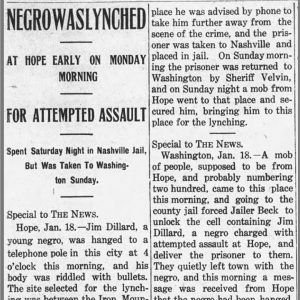calsfoundation@cals.org
Dillard (Lynching of)
On January 18, 1909, a young African American man was lynched in Hope (Hempstead County) for an attempted assault on a white woman. Newspaper reports differ on the victim’s name. While most stories give his last name as Dillard, the earliest report, published in the Arkansas Democrat on January 18, calls him Hillard. Reports on his first name are also confusing. The Washington Telegraph and the Arkansas Gazette identified him as Tom Dillard, while the Nashville News gave his first name as Jim. Some lists of lynching victims give his name as John. Census and other records cast no light on this confusion. For convenience, this entry will refer to him as Dillard.
According to reports, on Friday night, January 15, Dillard, described as a “country negro,” encountered a young white woman as she was walking home from her job at the Haynes Brothers store in Hope. He allegedly seized her and attempted to assault her. She screamed, and he ran, passing a man named J. P. Brundidge in his flight. Brundidge went to help the woman who, according to the Nashville News, was “in a prostrated condition.”
The Democrat and several other papers reported that Dillard was arrested the next morning and identified by his intended victim. The Nashville News, however, wrote that two African Americans were initially arrested but were released after the woman and Brundidge failed to identify them. According to the News, Dillard was then arrested and positively identified. He was originally jailed in Hope, and the sheriff tried to move him to the jail in Washington (Hempstead County) but was warned to take him farther away. He then took Dillard to Nashville, just over the Howard County line. On Sunday morning, Dillard was moved back to Washington.
In the meantime, according to the Democrat, “indignation ran high among the young men of the community [Hope], and there were many mutterings which culminated last night [Sunday] in the organization of a mob of fifty or more determined citizens.” That night, the mob, estimated at anywhere from fifty to 300 men, went to Washington and seized Dillard with little difficulty, the sheriff being out of town (as was the case with many such lynchings). The mob returned him to Hope.
According to the Gazette, echoing the tropes of many lynching reports, the mob moved with “the precision of a perfectly drilled army, and so quietly that none of the citizens knew what was being done.” Around 5:00 on Monday morning, Dillard was hanged from a telegraph pole in front of the Iron Mountain station, and fifteen to twenty shots were fired into his body.
According to the Democrat, “When the day dawned the city was amazed to witness the ghastly fruit which the telegraph pole had borne during the night.” The report went on to say that the members of the mob were unknown, “although there are strong suspicions as to some of them.” A coroner’s jury met and determined that Dillard had met his death “at the hands of unknown persons,” and the Gazette stated that “the people seem to think the negro met his just deserts.”
For additional information:
“Mob Hanged Negro to a Telegraph Pole Today.” Arkansas Democrat, January 18, 1909, p. 1.
“Negro Swung Up by Determined Mob.” Washington Telegraph (Washington, Arkansas), January 22, 1909, p. 1.
“Negro Was Lynched.” Nashville News (Nashville, Arkansas), January 20, 1909 p. 1.
“Quick Lynching of a Hope Negro.” Arkansas Gazette, January 19, 1909, p. 1.
Nancy Snell Griffith
Davidson, North Carolina
 Civil Rights and Social Change
Civil Rights and Social Change Early Twentieth Century, 1901 through 1940
Early Twentieth Century, 1901 through 1940 "Jim" Dillard Lynching Article
"Jim" Dillard Lynching Article  "Tom" Dillard Lynching Article
"Tom" Dillard Lynching Article 



Comments
No comments on this entry yet.